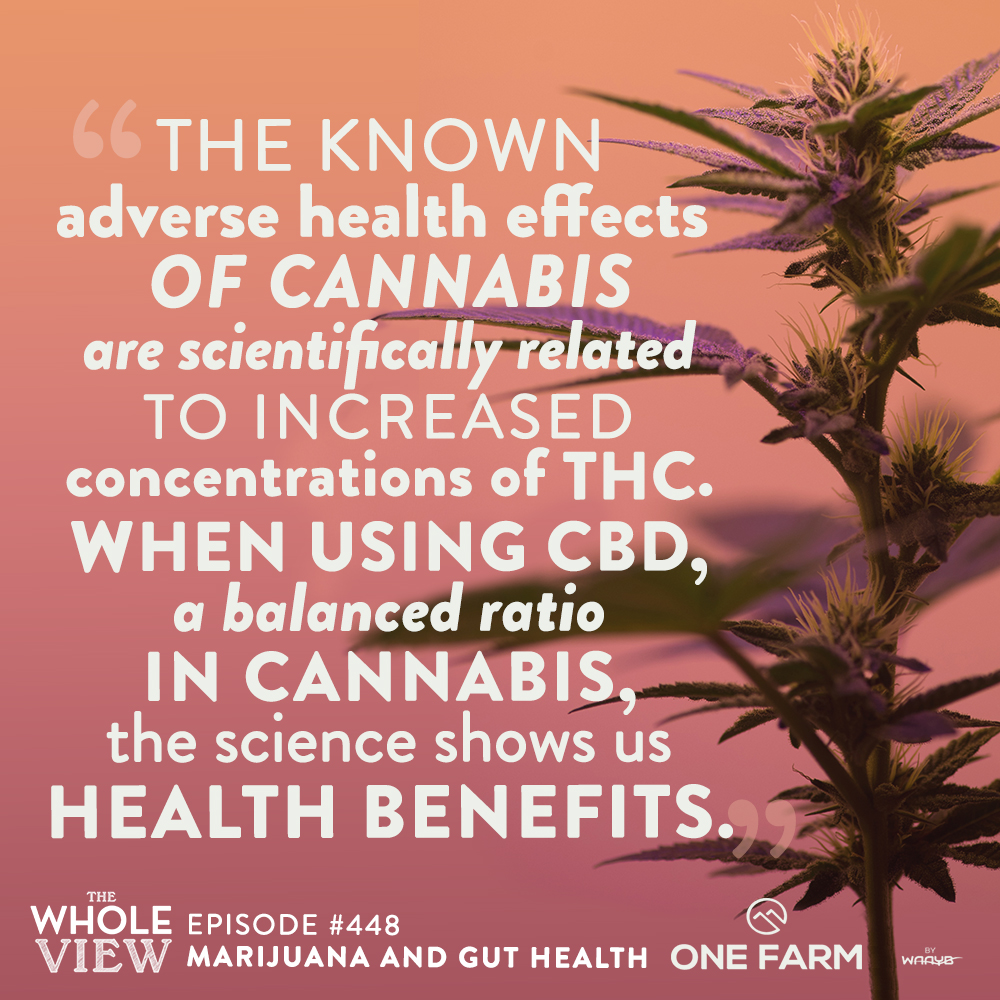
Welcome to episode 448 of The Whole View! This week, Stacy and Sarah break down the science behind Marijuana and gut health and look at the potential causes of CHS.
If you enjoy the show, please review it on iTunes!
The Whole View, Episode 448: Marijuana and Gut Health
Welcome back to episode 448! (0:28)
Sarah and Stacy have done shows on the topic of marijuana and wellness, including CBD, CBD for pets, and pain management.
This show is sponsored by One Farm, both Sarah and Stacy’s favorite CBD brands.
One Farm’s goal is to create the highest quality hemp extract on the market.
Their products are made with the best hemp, grown organically in the perfect climate, extracted without toxic solvents, and mixed with quality ingredients.
One Farm and their handling/processing facility are USDA Organic, which very few companies have.
By controlling everything from seed to shelf, One Farm gives you the assurance that everything they make is from our USDA Certified Organic hemp, lovingly raised, cultivated, and processed 100% by One Farm in Colorado.
Stacy notes that they also 3rd party test every batch that comes out of their USDA Certified lab.
Use the code WHOLEVIEW at checkout to receive 15% off your order!
Listener Question on Marijuana and Gut Health:
Today’s question about Marijuana and gut health comes from Dana (6:15):
“I love focusing on gut health. I’ve read your books plus Dr. Terry Wahls books. I rely on cannabis to help me manage some of the residual MS symptoms I have while I work on healing my body. I am greatly aware of the risk of developing CHS as it has been on the rise in the Medical marijuana community here in Portland. It’s terrifying to know that something that helps us so much, can harm us too.
My question: How does THC affect the gut and gut motility? How can we prevent CHS medical users who use regularly and sometimes heavily to help manage our diseases? There isn’t a lot of research I’ve found surrounding the effects of thc on the gut. I know it can slow down gut motility, but how much is too much and is there a way to counteract this effect? Does CBD have the same effect as thc on the gut or is it different? Can they work together in the gut to create a safer gut effect versus using a higher thc ratio?
Ratios are big in the medical world. We rely heavily on the science we are presented in regards to the best ratios for our specific disease. There needs to be more talk on the potential risks of cannabis and how to lower our chances of developing something like CHS since so many of us meet the criteria of being at high risk of developing it. Would love to hear your thoughts on this. Seriously. Thank you.”
CHS: Cannabinoid Hyperemesis Syndrome
As Sarah explains, CHS is a very rare syndrome that occurs in long-term, heavy users of THC-rich cannabis. (7:50)
It was only first reported in medical literature in 2004.
The reported symptoms include nausea, vomiting, and abdominal pain. Also, they are episodic, lasting for 24 to 48 hours, and not returning for several weeks or months.
More than 90% of cannabis users who experience these symptoms also have a compulsion to bathe in hot water during the episode.
This is often what helps doctors and patients determine CHS as the cause.
Sarah adds that vomiting can be severe and can leave CHS patients extremely dehydrated, acidosis, decreased serum bicarbonate, acute renal failure, and damage to the esophagus.
Because cannabis is usually known to help keep nausea and vomiting at bay, these users may end up using cannabis to keep the CHS symptoms at bay.
Hyperemesis symptoms are very resistant, and typical antiemetics, such as ondansetron and promethazine, don’t work. The treatment of choice is abstinence for a prolonged period.
The only other effective treatment currently is IM injection with Haloperidol (normally used to treat schizophrenia, schizoaffective disorders, and Tourette syndrome) or Olanzapine (normally used to treat schizophrenia and bipolar disorder).
Because of the use of antipsychotics, this suggests it’s not working through the “normal” ways that induce vomiting.
That it’s something more related to the central nervous system and not the GI tract.
The Difference Between THC and CBD
Sarah believes it’s critical to look at the differences between THC and CBD to see why CHS is rising. (13:15)
Both THC and CBD are plant chemicals that interact with the endocannabinoid system, an ancient lipid signaling system. It mediates between our emotional and physical reactions to pain.
THC is the most abundant chemical in cannabis. It’s also the cannabinoid responsible for the sense of euphoria or “high” that comes from using the plant.
CBD is the second most abundant chemical and doesn’t have the same psychoactive effects as THC.
The difference comes down to how each chemical binds with different receptors in our bodies and activates them.
CBD binds but doesn’t activate, which is why you don’t get the same sense of euphoria as THC.
Instead, it appears to modulate or adjust how the receptors respond to stimulation from other compounds.
THC creates mental status changes, motor function, memory, and body temperature by interacting with CB1 and CB2 receptors. This can manifest as euphoria accompanied by increased heart rate, anxiety, hunger, and eventually sleepiness.
CBD
CBD does not have psychoactive effects for most people or very weak effects on sensitive people. (17:30)
Instead is associated with:
- Neuroprotective
- Anti-inflammatory
- Antioxidant
- Analgesic
- Antipsychotic
- Anti-anxiety & antidepressant
As we talked about in TWV Podcast Episode 420: CBD for Pain Management, both THC and CBD have been shown to reduce pain.
Both CBD and THC also have strong antiemetic effects.
Also, THC increases appetite and can have a sedating effect useful for insomnia.
Because of the combo of increasing appetite and decreasing nausea, cannabis is often used by cancer patients when they’re undergoing chemotherapy.
High-THC Marijuana And Gut Health
Stacy adds that the drug industry has actually altered these plants and bred them to yield higher THC concentrations. (20:01)
The decreasing levels of CBD are an unintended consequence of that practice.
In the old days of finding wild marijuana, THC and CBD’s typical levels would be about 50/50.
In the 1990s, typical “joints” contained 1–3 mg of THC. The typical joint in Colorado now contains 18 mg of THC or more.
Also, Emergency room patients have self-reported smoking up to 2,000 mg or more of THC in a day.
Higher potency products are associated with an increased risk for CHS and an increased risk for psychosis and other types of weed sickness, such as Cannabis Use Disorder.
However, CHS is still considered a pretty care complication.
What Are the Chances of Developing CHS?
About 75% of CHS cases report daily or more than daily cannabis users, most of the remaining use at least weekly, very few cases are less often than that. (25:50)
Sarah adds that there aren’t many good epidemiological studies out there right now. But there are a lot of case reports and series to look at for data.
About ⅔ of patients diagnosed with CHS have been using cannabis for at least 2 years before symptom onset.
So far, CHS cases’ demographics reflect the demographics of cannabis users, so it doesn’t look like any particular population is at greater risk.
So, this increase likely reflects increased use. A study that investigated trends of marijuana use between 2002 and 2014 indicated that prevalence is increasing among both men and women.
Data from the US national survey on drug use and health show that 12.4 million men and 7.7 million women used marijuana in 2002. This number increased to 18.4 million men and 11.7 million women in 2014.
Sarah notes that we’re not quite sure why some people who use cannabis daily develop the condition and others don’t.
Current estimates are that 12% of Americans are active cannabis users.
Another study showed that CHS sufferers had to seek medical attention an average of 7 times before getting diagnosed.
Sarah does this quick math:
- This would place CHS risk for near-daily to daily users of cannabis anywhere between about 0.2% and 1%. (1 in 100 to 1 in 500)
- The risk for more casual users would be much, much, much lower, using the same back of the envelope math, about 0.003% (1 in 30,000)
A similar study in Colorado showed the incidence of CHS about doubled after legalization of cannabis.
What Does It Mean?
Medical marijuana is on the ride in many areas. Stacy wonders about the implications this could have on health.
Sarah reminds listeners that this is very rough data. She did very rough math to give everyone a general idea of how common this complication.
She also dug deep, looking for similar health issues caused by high-CBD use, and found one paper so far with very little data listed.
Sarah found a narrative article that mentions it can very rarely be seen with high CBD use, but not a single published case study to look at. So, it’s unclear if the claim is actually true.
In fact, there’s a postulation that increasing CBD could protect against CHS. The combination of high THC and low CBD in high-potency cannabis is driving whatever maladaptation is behind CHS.
The Mechanisms Behind CHS
Sarah explains that, so far, no good quality data pointing to exactly what is causing CHS.
Cannabinoids may bind to CB-1 receptors in the gastrointestinal tract and decrease GI motility and gastric emptying. This may override brainstem-mediated antiemetic effects and precipitate hyperemesis. [9, 92, 95, 132]
Chronic cannabis use leads to desensitization and downregulation of CB1 receptors that ordinarily have peripheral antiemetic effects. This causes rebound vomiting and spasmodic pain that abates with abstinence and corresponding recovery of CB-1 receptor activity. [98, 136, 185]
In chronic cannabis users, cannabinoid metabolites may accumulate in the brain and fatty tissues, inducing a toxic effect. [90, 94]
Patients susceptible to developing CHS may have a genetic variation in their metabolic enzymes resulting in toxic levels of cannabinoid metabolites [131]
THC may act as a partial agonist on CB1 receptors and thus relatively antagonize the effects of full endogenous agonists on these receptors. This would precipitate sudden withdrawal and hyperemesis in sensitive patients. [97, 105]
THC causes dilation of splanchnic vasculature, resulting in CHS. Hot bathing leads to peripheral vasodilation and shunts blood away from the splanchnic bed, resulting in symptom improvement. [102, 137]
Marijuana and Gut Health
Stacy adds that if you live in an area where marijuana is legal, people who work in the shops that sell it are educated on the topics and can point you to what will work best for your needs. (46:30)
Sarah underlines that she doesn’t want this show to scare away anyone from using CBD that might benefit CBD.
Results show normalization of overall appetite and increased/decreases in some circumstances. It also shows a reduction preference for fatty foods- especially polyunsaturated fats.
It’s also believed to relieve diarrhea and abdominal pain, improve appetite in IBD, reduce inflammation and histamine in the gut, prevent mast cells from releasing histamine, and reduce intestinal inflammation in various models and humans.
Data also suggests that THC and CBD’s use improves gut barrier health and reduces intestinal permeability in a variety of models.
The Gut Microbiome
The blocking endocannabinoid system causes gut dysbiosis and endotoxemia.
A 2015 mouse study showed THC reduced weight gain, fat mass gain, and energy intake in Diet-Induced Obese but not lean mice.
This 2019 mouse study showed THC and CBD could improve experimental MS (reducing inflammation and clinical signs of paralysis) with effects at least partly mediated via improvements to the gut microbiome, preventing dysbiosis normally associated with MS.
Another 2020 study used CBD plus fish oil in the mouse model of colitis and showed that CBD and fish oil had small benefits. However, both had additive benefits when used together, including reducing inflammation, reducing intestinal permeability, and improving the gut microbiome.
More of Sarah’s Citations:
Epidemiology of cannabis use:
- https://www.ncbi.nlm.nih.gov/pmc/articles/PMC5719106/
- https://www.cdc.gov/mmwr/volumes/65/ss/ss6511a1.htm
Basics:
CHS Review articles:
- 2011 https://www.ncbi.nlm.nih.gov/pmc/articles/PMC3576702/
- 2017 https://www.ncbi.nlm.nih.gov/pmc/articles/PMC5330965/
- 2019 https://digitalcommons.chapman.edu/physician_assistant_articles/6/
- 2020 https://www.ncbi.nlm.nih.gov/pmc/articles/PMC6194425/
- 2020 https://www.ncbi.nlm.nih.gov/pmc/articles/PMC7599351/
- https://pubmed.ncbi.nlm.nih.gov/33208685/
- 2021 https://pubmed.ncbi.nlm.nih.gov/32673642/
- Seems to be due to THC to CBD ratio: https://www.ncbi.nlm.nih.gov/pmc/articles/PMC6690288/
CBD and Gut Health
- https://pubmed.ncbi.nlm.nih.gov/31803950/
- https://pubmed.ncbi.nlm.nih.gov/33162890/
- Inflammation https://pubmed.ncbi.nlm.nih.gov/31764093/
- Cannabis https://pubmed.ncbi.nlm.nih.gov/27792038/
- THC https://www.ncbi.nlm.nih.gov/pmc/articles/PMC4669115/
- Endocannabinoids https://pubmed.ncbi.nlm.nih.gov/27792038/
- Gut barrier https://www.ncbi.nlm.nih.gov/pmc/articles/PMC5333598/
Final Thoughts
When Sarah looks at all this data together, she definitely feels it’s worth having a conversation with your healthcare provider if you’re planning to use marijuana for medial purposes. (57:22)
Sarah and Stacy are big fans of CBD for its diverse benefits. And that it doesn’t have the problems associated with chronic cannabis use.
Thank you to One Farm for not only sponsoring this show but having a trustworthy and high-quality product.
Stacy adds that she’s so appreciative of their third-party testing because that’s not a practice that’s regulated.
If you’ve not yet joined the Patreon family and want to know how Stacy and Sarah really feel about this topic, hop over for more bonus content and stories.
Thank you for listening!





